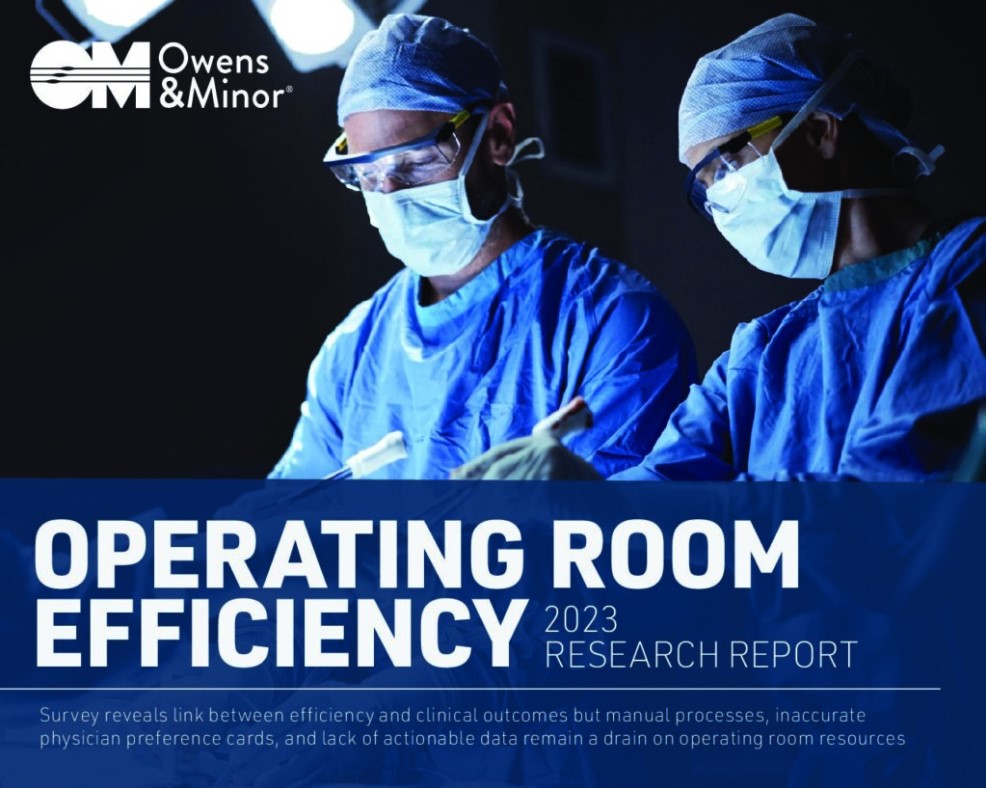Operating room (OR) teams are stressed by increased workloads, staffing shortages, and supply chain disruptions. Supply management and documentation, while high on the priority list for Perioperative leaders, should not be a burden that falls on the shoulders of clinicians – nor does it have to be.
These are some of the key findings from a new survey conducted by the Association of Perioperative Registered Nurses (AORN) and commissioned by Owens & Minor.
ORs have implemented technology solutions across many of their processes, which drive higher utilization and greater clinician satisfaction, but they still handle 40% of them with manual intervention, specifically those related to supply management.
This points to a significant opportunity for Perioperative leaders to address two of their top challenges – staffing and supply chain – through further digital expansion.
OR teams doing more, feeling stressed
Over half (59%) of Perioperative leaders report their current working environment as “stressful” or “extremely stressful,” and more than three-quarters (77%) say their workloads have grown “more” or “a lot more” since the pandemic began.
When asked about specific challenges in their ORs, 62% rated supply related factors as “very” or “extremely” problematic. Supply challenges include supplies not stocked and readily available for a procedure (30%), documenting products used during a procedure (20%), and products expiring before being used (12%).
Supply chain optimization critical to success
The survey results indicate that Perioperative leaders understand the impact of supply chain issues on OR workflow efficiency, with greater efficiency correlating to better patient outcomes.
The vast majority of those surveyed (94%) rated supply chain optimization as “very important” or “extremely important” to the optimization of their ORs, with more than half (54%) rating it as “extremely important.”
But supply management shouldn’t fall just to clinicians
OR teams already struggling with more work and not enough staff to do it don’t need the added responsibility of filling gaps in the Perioperative supply chain. In fact, the National Library of Medicine-funded 25×5 Symposium has set a goal to reduce clinical documentation burden by 25% by 2025.1

Of survey respondents said supply chain optimization was very or extremely important to the optimization of their ORs
Physician preference cards rose to the surface as a major driver of work and rework for Perioperative teams. About one in four OR leaders (23%) report using a manual process where nurses write changes on paper preference cards. This preference card management methodology correlated to the lowest levels of satisfaction (18%) and ease of use (49%).
Greater efficiency and satisfaction from technology enabled processes
In Perioperative departments where supply chain activities are 100% digital, the average OR utilization rate is 71%.
While OR utilization was the key performance indicator (KPI) most associated with greater use of technology solutions, the survey findings suggest an opportunity for OR teams to leverage technology to improve OR efficiency KPIs across the board (e.g., on-time starts, starts within the target turnover time, case pick accuracy).
The survey also reveals the shift from manual to technology enabled workflows can improve clinician satisfaction, particularly when it comes to physician preference cards. Ease of card management (81%) and card satisfaction (44%) are highest when an OR nurse can make preference card changes directly in a technology solution.
When a hospital makes it easier for an OR team to have the right products in the right places at the right times, document their usage in the patient record, and trigger replenishment to maintain appropriate inventory levels, then clinicians can focus on their priority – the patient.
Industry partners are here to help
To alleviate OR teams of supply management burden and boost efficiency, hospitals have turned to the Owens & Minor SurgiTrack® solution, a clinical supply delivery service that delivers ready-to-use custom surgery packs right to the OR based on procedure and physician preference.
Designed for highly complex, high-volume cases, OR teams have 80% to 90% of the supplies they need for a surgery in a single kit, significantly reducing the number of items they must pick for a case (and potentially waste or return).
Learn more about leveraging the SurgiTrak® solution to take the stress out of supply management.
Looking For More Of The Latest Trends In Operating Room Efficiency
The 2023 Owens & Minor Operating Room Efficiency Research Report presents key findings from the survey of 250 perioperative leaders. This report offers quantitative insights into how efficiency in an operating room correlates to patient outcomes and drills down into specific factors that generate unnecessary labor costs and waste.

















